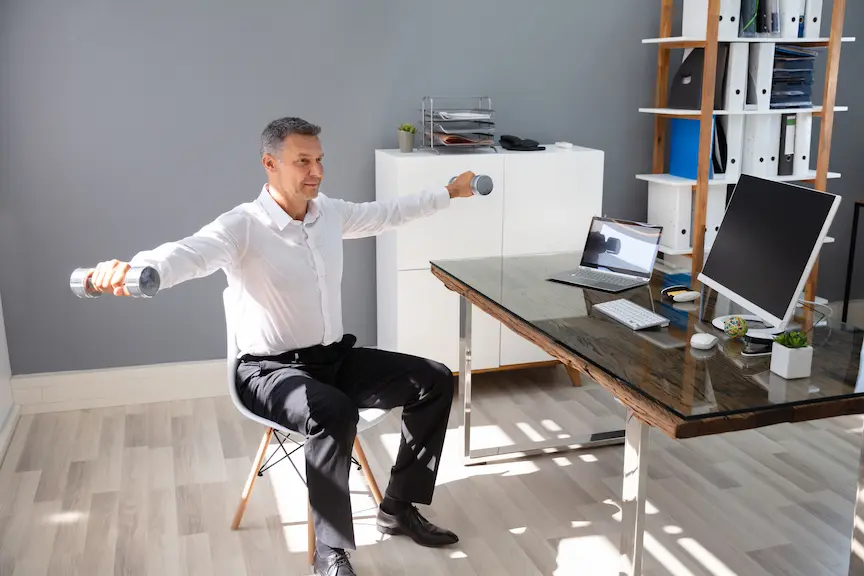
Week 7 - Activity
Introduction
Week seven is all about getting yourself moving more. There are a huge number of benefits to activity, particularly activities that build muscle: speeding your metabolism up, balancing your blood sugars, and reducing cravings. Being active can also boost your mood, improve the quality of your sleep, and improve your mental health. Taking even small steps to increase your activity level can have a huge impact on how you feel and how you manage your weight.
1-
Welcome to week 7 from the Lifestyle Medicine team.
There’s a huge number of benefits to being regularly active; it can help control your weight, balance your blood sugars, boost your mood, improve the quality of your sleep, improve your general and mental health, and has even been found to improve brain function and reduce the chances of developing dementia.

How does being active help weight loss?
Regular activity can increase your metabolism, which helps with weight loss (1). Your metabolism, or basal metabolic rate (BMR), is personal to you and is affected by your body composition (which includes if your body is composed of more fat or more muscle). For example, muscle tissue is very metabolically active so it uses up a lot of energy (that is, it burns up lots of calories) even when you're resting. Whereas fat tissue is much less metabolically active. In other words, two people who weigh the same but one has high muscle mass and the other has higher fat mass, will have different basal metabolic rates. This means the person with higher muscle mass will use up more energy or calories at rest, and even more when they exercise, because of their higher BMR.
Body Fat Percentage
Your body fat percentage helps you understand if your body composition is healthy or if you need to lose fat mass and build more muscle mass to improve it. Your body fat percentage is a key indicator of your health and risk of chronic disease. To calculate your body fat mass we advise using bio-impedance scales, alternatively fat mass can often be measured at your local gym. Healthy body fat levels for males are in the range of 17.6%–25.3% and 28.8%–35.7% for females (8). When you start to exercise more your body will start to naturally build more muscle, a process which uses energy. This means that as well as getting fitter and stronger, you'll naturally burn more energy, because of your increased muscle tissue, even when you're at rest. This means your BMR will increase. So having a good amount of muscle will help you to maintain a healthy weight (2).
What counts as activity?
Pretty much any movement counts! The benefits of being active increase if during exercise you're able to increase your heart rate or you get active to the point that you feel slightly out of breath. You can start where you are - this is not a competition with anyone else. Take stock of the amount of activity you do every day and make a plan - could you add in an extra 10 minutes of movement to your day? Increasing your activity doesn’t need to involve joining a gym or sports club if that’s not your thing. It can be as simple as taking a brisk walk, doing bicep curls using soup tins, cleaning the house, dancing, swimming, gardening, playing with the kids outside…. the list is endless. What would you enjoy doing?

If you're less mobile, it's just as important to consider ways to maintain your muscle mass - bicep curls with or without added weights, passive limb exercises or chair yoga are good options. For more ideas click on this link. The more enjoyable you make it, the easier it will be to stick to a new commitment to increased activity. Using your favourite music to motivate you can help you keep active for longer (3). Involving friends or family and doing an activity together could make it more fun and also keep you accountable when it comes to making plans.
Exercise: Ideas for getting active
- Walking
- Yoga/chair yoga
- Jogging/running
- Swimming
- Dancing
- Cycling
- Gardening
- Weight training
- Interval training
- Resistance bands
- Something else?
What are you going to do?
Have you added this to your Activity Planner?
Free Downloads
2-
The Risks of Being Inactive
We all know that smoking is one of the biggest preventable causes of death in our current times. BUT, did you know that inactivity is now understood to increase your risk of ill health and a premature death (4)? The UK government has set physical activity guidelines (5), which tell us that for physical and mental health, adults should do some physical activity every day. The recommendation is that you should be active for at least 2.5 hours or 150 minutes every week. This is just over 20 minutes a day, minimum. As well as this, you should avoid long periods of sitting, break these up with some light activity. Even getting up and doing a quick stretch, going up and down a flight of stairs, or walking around the block counts.

Don't worry if right now you're physically inactive, which means doing less than 30 minutes of activity a week, you're not alone. A health survey done in England in 2012, showed that 1 in 4 women and 1 in 5 men are classified as ‘inactive’ (6). BUT you can so easily change this before it has long lasting negative effects on your health. There are lots of hidden benefits to increasing your physical activity. One example is it helps increase the strength of your heart muscle and this can help to keep your blood pressure low. Both of these things will help to reduce your risk of heart disease. Being regularly active can also reduce the unhealthy cholesterol in your blood and can therefore lower your risk of having a stroke, getting dementia or even cancer (7).

How To Get Started With Activity
- Start with where you are now - take stock and make a plan.
- Set an activity goal for the week.
- Set a daily movement target.
- Aim to be active a minimum of 5 times a week and work up to 30 minutes a day*
- Be realistic and do something you enjoy.
- What are you going to do?
- Record your movement on your Activity Planner or Food and Symptom Diary.
- Set reminders on your phone or make an appointment in your diary with yourself - this can be a great first step in making a new habit.
- Use your free Activity Planner, print it out and pin it up somewhere you'll see it as a reminder and tick off your activities as you do them each day.
- Remember to keep celebrating your achievements to support your motivation. Even checking things off a list can give you a mood boosting dopamine hit.
*If 30 minutes is too much in one go, break this down into bite sized chunks of 10 minutes at a time 2-3 times a day.
Exercise Snacking
Exercise snacks are a relatively new idea which research has found to be a great way to improve your physical health (9). “Exercise snacks” involve doing short bursts of activity a few times in the day.
Challenge: Can you swap one of your food snacks for an exercise snack? The exercise you choose can be anything you like, here are some suggestions:
- Bouncing on a trampette
- Push ups against a wall / or on the floor
- Sit to stand reps
- Squats
- Dancing to a favourite song
Free Downloads
Resources in this article
References
- 1. Sjödin AM, Forslund AH, Westerterp KR, Andersson AB, Forslund JM, Hambraeus LM. The influence of physical activity on BMR. Med Sci Sports Exerc. 1996 Jan;28(1):85-91. doi: 10.1097/00005768-199601000-00018. PMID: 8775359.
- 2. McPherron AC, Guo T, Bond ND, Gavrilova O. Increasing muscle mass to improve metabolism. Adipocyte. 2013 Apr 1;2(2):92-8. doi: 10.4161/adip.22500. PMID: 23805405; PMCID: PMC3661116.
- 3. Thakare AE, Mehrotra R, Singh A. Effect of music tempo on exercise performance and heart rate among young adults. Int J Physiol Pathophysiol Pharmacol. 2017 Apr 15;9(2):35-39. PMID: 28533890; PMCID: PMC5435671.
- 4. Katzmarzyk PT, Janssen I, Ardern CI. Physical inactivity, excess adiposity and premature mortality. Obes Rev. 2003 Nov;4(4):257-90. doi: 10.1046/j.1467-789x.2003.00120.x. PMID: 14649376..
- 5. UK chief Medical Officers Physical Activity Guidelines 2019 Dept of Health and Social Care accessed (LINK)
- 6. Oliver T Mytton, Nick Townsend, Harry Rutter, Charlie Foster, 2012 Green space and physical activity: An observational study using Health Survey for England data, Health & Place, Volume 18, Issue 5, Pages 1034-1041, ISSN 1353-8292( LINK)
- 7. Nystoriak Matthew A., Bhatnagar Aruni 2018 Cardiovascular Effects and Benefits of Exercise Frontiers in Cardiovascular Medicine VOLUME 5
- 8. Branco BHM, Bernuci MP, Marques DC, Carvalho IZ, Barrero CAL, de Oliveira FM, Ladeia GF, Júnior NN. Proposal of a normative table for body fat percentages of Brazilian young adults through bioimpedanciometry. J Exerc Rehabil. 2018 Dec 27;14(6):974-979. doi: 10.12965/jer.1836400.200. PMID: 30656157; PMCID: PMC6323334
- 9. Perkin, Oliver & McGuigan, Polly & Stokes, Keith. (2019). Exercise Snacking to Improve Muscle Function in Healthy Older Adults: A Pilot Study. Journal of Aging Research. 2019. 1-9. 10.1155/2019/7516.




